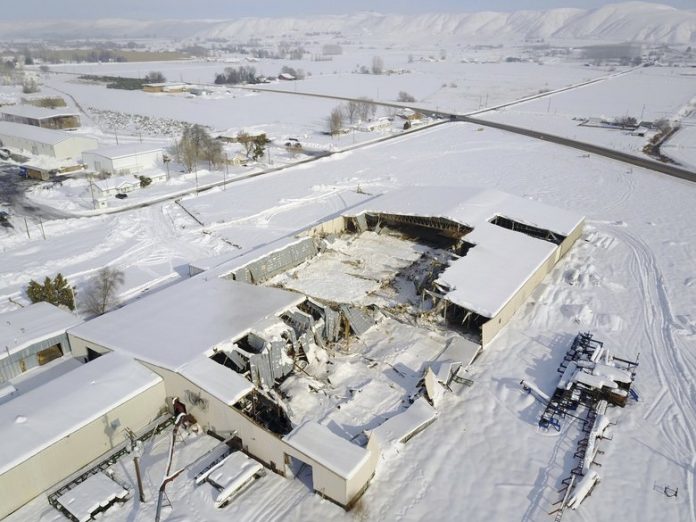
The roof of the bowling alley in Weiser, Idaho, came crashing down first on Jan. 9.
“I had seen the snow right at the top doing down,” Jason Schmitz, the owner of a body shop next to Weiser Lanes told KBOI2. “But in fact it wasn’t sliding off the side, it was just going down.” One of the town’s few distractions for teens and families – gone.
Then, last week, the roof of Ridley’s Family Market in Weiser collapsed. Twelve men, led by manager Shane McInroy, had been clearing the four feet of snow that had accumulated from a month-long series of storms when the middle of the roof gradually began to groan and sink.
“We retreated further to the edge. I called 911 at 11:10 a.m. Then some good Samaritans threw us some ladders, and we got down,” McInroy told the Idaho Statesman.
Ridley’s is the only grocery store in Weiser, and the loss was felt immediately – the next nearest grocery store from the town of 5000 is 15 miles away.
But quickly a discount store that was being remodeled gave up the space for the groceries to be housed. Steve Penner, Public Information Officer for Washington County Disaster Services, estimates that it will be 5 to 10 weeks until Ridley’s can be rebuilt.
The roof of the Gospel Tabernacle Church is gone too. Pastor Jerry Cate told East Idaho News that “I’ve talked to a couple people in church and there are just tears in their eyes.”
Another woman and her dog were home when their roof came down one evening. Fortunately the woman was able to “leap underneath the bed and wait until the noise stopped,” Penner said. The snow only went through to the ceiling, so neither woman nor dog were hurt.
Five hours to the north, in Deary, another woman was not so fortunate. She stepped out onto her porch last week at the exact moment when the snow and ice on its roof became too much for it. The woman was found by a family member, Latah County Sheriff Richie Skiles told KLEW TV. She had not been able to “get out from under the weight,” he said. “It was very tragic.”
More than 100 building roofs have collapsed in Washington County, where Weiser is located, prompting Gov. C.L. “Butch” Otter to declare a state of emergency there and in Payette County.
The extra money will allow the small towns to hire help for the town’s city workers in clearing the snow from roofs and roads after the month-long period of “extreme” weather.
Not to be forgotten is the fact that this is onion country, dotted with onion sheds. They’ve been hard hit too.
Some 18 onion storage facilities have collapsed, among them four belonging to Murakami Produce. At least three “will be out of commission the rest of the season and several are wounded,” Grant Kitamura, Murakami general manager told Capital Press.
The region’s onion processing has been cut by about 25 percent.
The source of the problem lies both in the amount of snow and in the structural integrity of the buildings. The buildings that had collapsed had all been fairly old, Weiser police chief Carl Smith told The Post. Some are absentee-owned and not well maintained.
The ultimate weight of the snow, according to National Weather Service, Boise’s Warning Coordination Meteorologist Jay Breidenbach, was 39.5 lbs. per square foot in the eastern side of Weiser, and 38.5 lbs. per square foot in the western side of Weiser. Weiser’s buildings, she estimated, had only been designed for 25-30 lbs. per square foot of snow.
According to Breidenbach, the first major snowfall began on Dec. 22 and went through Dec. 24, dropping 8 to 9 inches on Weiser. On Jan. 2 and 3, another storm dropped another 8 or 9. Then, on Jan. 9 and 10, nearly a foot came down.
Finally, on Jan. 18 and 19, 14 to 15 inches of snow were recorded.
Meanwhile, the temperature never went above freezing.
Most of the roofs began collapsing on Jan. 20, after approximately 4 feet of snow had accumulated.
Breidenbach called the weather “unprecedented,” noting that the closest approximation was in 1948 and 1949.
Calculating the amount of snow a building can hold is quite complicated. But it has to be done when constructing structures: too high a load-bearing estimate and you overspend on construction; too low and you can have a disaster.
In 2016, a group of researchers from the University of Idaho changed the thirty-year-estimate of Weiser’s ground snow load from 32 lbs. per square foot to 17 lbs. According to Richard Nielsen, a member of the group, they had redone the predictions with years of data from the National Weather Service and the National Conservation Practice Standards.
“When we redid our analyses, the math said we should cut down to 17 lbs. [for Weiser],” Nielsen told The Post. “It’s pure speculation on my part, but possible that this was a 100 year storm, and we based our estimate on a 50 year storm.”
Currently there are 24 inches of snow on the ground, with more snow expected in the area next week, leaving in question how the area will continue to deal with the accumulation. “We have so little places to put [the snow] any more,” Smith said. Weiser, he noted, only has so many dump trucks.
“There’s a lot of scared people,” he said.
Featured Image: Jason Brainerd/Rapid Aerial LLC via AP
(c) 2017, The Washington Post

